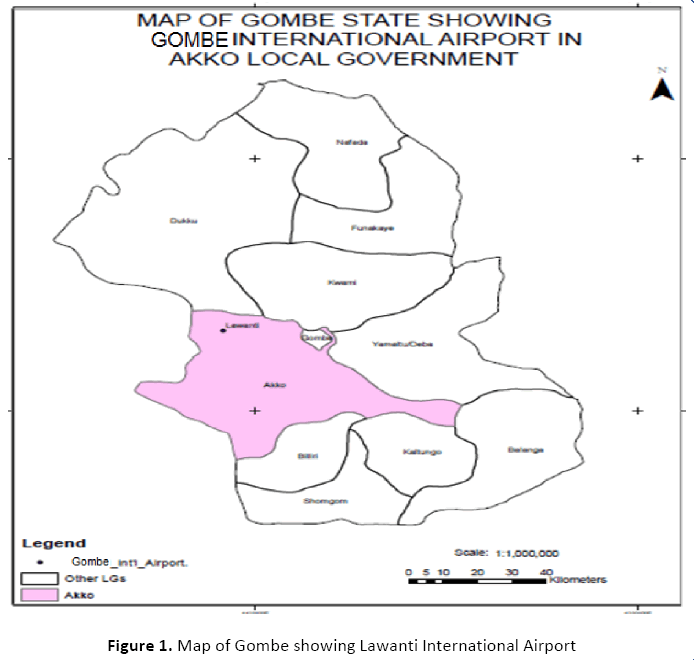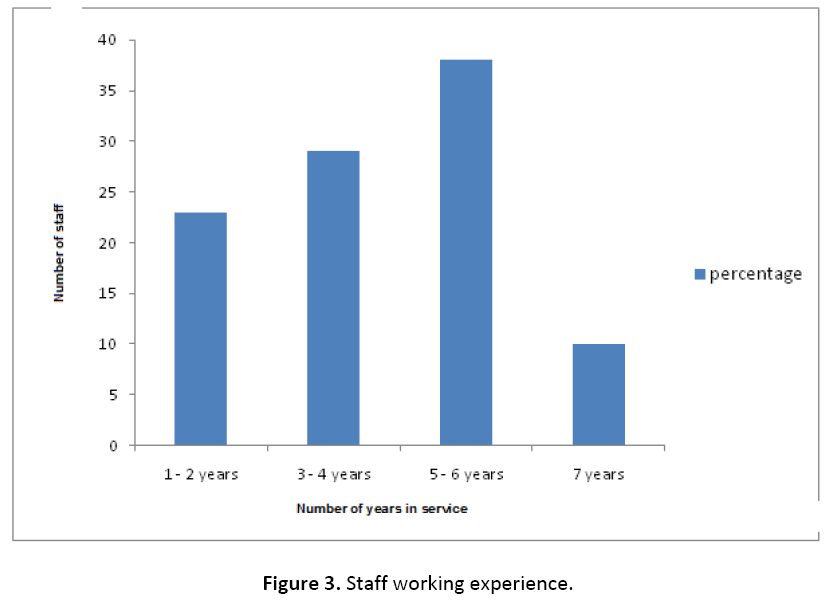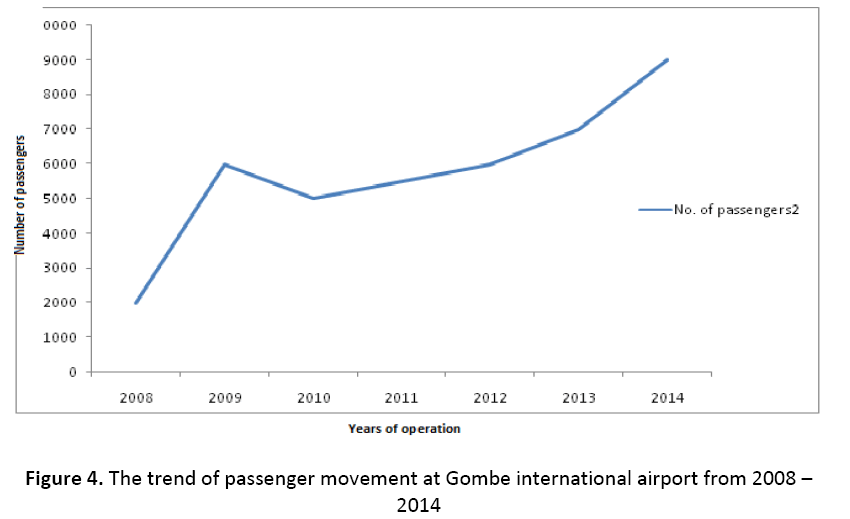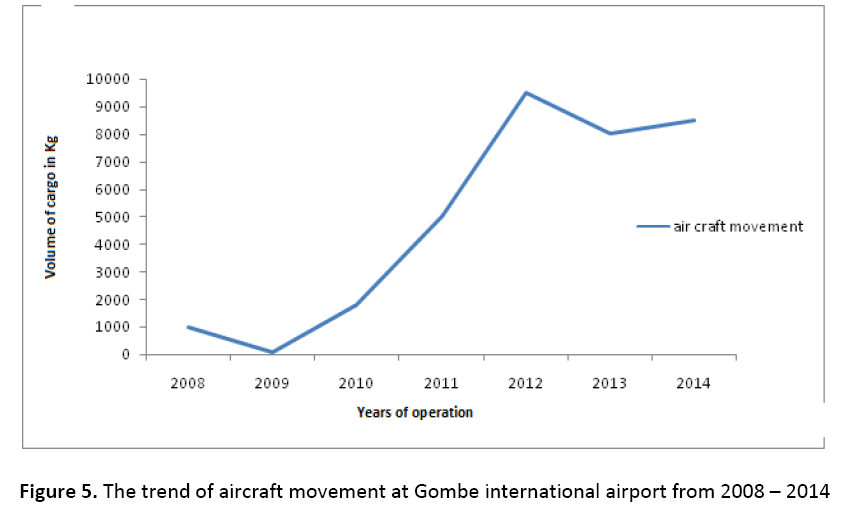ISSN : 2393-8854
Global Journal of Research and Review
Analysis of the Economic Benefits of Gombe International Airport in Nigeria
1Department of Geography, Ahmadu Bello University, Zaria, Nigeria
2Department of Geography, Federal College of Education, Zaria, Nigeria
Abstract
This study examined the economic benefits of Gombe International Airport. The study used secondary and primary data acquired from questionnaire survey. The respondents for the questionnaire survey were randomly selected from the passengers, and purposively sampled from the management and staff at the airport. The data was analyzed using descriptive statistics and line graph. Findings revealed that the airport has attracted local and foreign investors to the region; created job opportunities; provided a lot of revenues, and boosted the regional and international trade in the area. However, the growth of the airport is constrained by inadequate facilities and infrastructure. It is therefore recommended to upgrade the facilities and infrastructures at the airport in order to increase the economic benefits of the airport.
Keywords
Aviation industry, Air transport, Economic benefit, Gombe State International Airport.
Introduction
The aviation industry facilitates international trade by providing fast global transportation network. Globally, there are about 36,000 air routes connecting the world’s cities. In 2011, airlines have transported about 2.8 billion passengers and over 47 million metric tons of air cargo through these routes [1]. In addition, the industry boosts a nation’s economic development by creating jobs, promoting internal trade and providing other aviation services. Air transport is one of the world most important industries [2], because it facilitates socio-economic growth and development. A report by the International Air Transport Association [3] asserts that the economic benefits of air transport include employment generation, wealth creation, revenue generation, and service provision to the tourism industry. The report estimated that the total economic input of the industry was US$ 710 billion in 1989 of which 200 billion was direct expenditure, 210 billion was indirect expenditure, and 300 million induced expenditure. The industry was estimated to support 21.6 million jobs in 1989, which increased to 30 million by 2010. Europe is important as a centre for international air transport activity with 31% of world-wide passenger kilometers taking place within the region.
The Oxford Economics (2010) [4] analyzed the socio-economic benefits of the aviation industry in over 80 countries of the world. Findings revealed that the economic benefits of the industry include significant contribution to gross domestic product (GDP) and revenue generation for the countries. Likewise, it is reported that the aviation industry generates close to half million jobs in Africa and contributes more than US$ 11 billion to African GDP [2].
Airports are an important part of regional economic infrastructure [5] which contributes significantly to economic growth and development. In addition, the growth of air service access can increase the growth potential of a region by attracting investment and promoting internal and external trade [5].
Air transport provides the connectivity and accessibility required in modern economic and social systems [5]. Hence, a good and well connected transport system is crucial to support economic growth and development. Air transport accessibility promotes industrialization. This is because industries require air services for the transport of their raw materials and finished products [5]. Air transport has a unique advantage over all other modes of transport because it can overcome distance within the shortest possible time.
Moreover, the availability of air transportation services effectively increases the extent and duration of economic activities in a region. The regional economic activity in turn generates the demand for air transport; resulting into positive correlation between the amount of air travel and GDP [6]. For example, it is estimated that air transport contributed 2.6% of the European Union (EU’s) GDP [7]. Although air transport can serve as a major driver of a country’s GDP, its contribution to the GDP in Nigeria is not substantial [8].
Gombe is one of the growing states in Nigeria. In 2005, the state government started making plans to establish Gombe International Airport. These included feasibility studies, environmental impact assessment and huge capital investment on the project. The plans continued for 3 years and the airport was certified for flight in 2008. Although the airport has been operational for 6 years, its economic significance has not been assessed. Therefore, the aim of this study is to analyze the economic benefits of Gombe International Airport with a view to understand the impact of air transport on the development of the state and regional economy.
Study Area
Gombe is located in the centre of the northeastern Nigeria on latitude 9° 30’ and 12° 30’N, longitude 8° 5’and 11° 45’E as shown in Figure 1. It has a land area of 20, 265 Km2. The state has an international airport which is located at Lawanti village some 10 kilometers away from Gombe, the state capital. It is also surrounded by other four international airports located in Kano, Jos, Yola and Maiduguri. The state had an approximate population of 2,353,879 million people (2006 census figures). Gombe has two distinct climates, the dry season (November-March) and the rainy season (April-October) with an average rainfall of 850mm annually.
Methododlogy
This study utilized both primary and secondary data.
Primary Data
The primary data was acquired from the following sources:
• Field observation: Here, direct method of observation was used to examine the nature of the airport, available facilities and infrastructures at the airport, and various economic activities practiced by those who work directly and indirectly within the airport.
• Questionnaire survey: In this case, useful information about the nature of the airport, available facilities and infrastructures at the airport was obtained from respondent that were sampled from the passengers, the management and staff at the airport. A total of 250 questionnaires were administered to the respondents. Two hundred questionnaires were administered to passengers that were selected using random sampling technique. While 50 questionnaires were administered to staff that were purposively sampled from the following departments: Aeronautical Information Service (A.I.S), Account and Finance section, Nigerian Meteorological Agency (NIMET), Aerodrome Rescue and Fire Fight Services, Works, ATC, and Communication.
Secondary Data
The secondary data was sourced from the Ministry of Works and Infrastructure in Gombe state. The data covered a period of 2008 to 2014. It provided information on trend of cargo movement, total passengers movement, revenues generated and the level of employment (directly and indirectly) within the airport over the period of study.
Method of Data Analysis
The descriptive statistics and line graph was used in analyzing the data.
Results and Discussion
The following sections examine the demographic and socio – economic characteristics of the respondents, trends in cargo and passengers movement at the airport to achieve a detailed analysis of the economic benefits of the international airport in Gombe state.
Demographic and Socio – Economic Characteristics of the Respondents
The sex and age distribution of a population has significant impact on the economy of a region because of its significant demographic, economic and social implications.
Sex Group
Sex distinguishes individuals (male and female) according to their function in a population. Figure 2 indicates that majority of the respondents (75%) are males and 25% of them are females. This implies that males patronize the aviation industry more than females in the study area. It was also found that 60% of the respondents are married, 28% are single, 7% are separated and 5% of them are widowed. This indicates that majority of those who patronize the air services in the area are married.
Age Group
The age structure as presented in Table 1 showed that the age group 31 – 40 years has the highest percentage (40%), followed by 26 – 30 years with 36%, then the age group 41 years and above with 14%; and finally the age group 20 – 25 with just 10% having the lowest percentage. This indicates that majority of those linked to the aviation industry in the area belong to the productive and economically active group of the population. Besides, Alperovich and Machines (1994)9 found that accessibility to air transport is not only influenced by age structure but remarkably correlated with seasonal wealth. That is the income level of individuals because air transport in more expensive than other means of transport.
Table 1: Age structure of the Respondents
| Age Group | Percentage |
|---|---|
| 20 – 25 | 10 |
| 26 – 30 | 36 |
| 31 – 40 | 40 |
| 41 and above | 14 |
Working Experience
Numbers of years spent on the job is very important because it helps one to gain knowledge and experience on the job over time. This relates to the staff of the airport. It is observed in Figure 3 that majority of the respondents are highly experienced and could provide reliable information for this study.
Nature of Growth of the Airport
It was found that air transport is positively correlated with economic development [10-12]. This section describes the nature of growth of Gombe International Airport from 2008 to August 2014. The growth of an airport can be described as slow, moderate or rapid. About 70% of the respondents described the nature of growth the airport as moderate, 23% noted that the growth is slow and only 7% are of the opinion that the growth is rapid. Although, the rate of passenger and cargo movements at the airport has not been steady, statistics from the Digest of Transport Statistics (2008)13 and the Federal Airport Authority of Nigeria (FAAN, 2014) [14] as presented in Table 2, Figures 4 and 5 confirmed that the growth of the airport is moderate. The moderate growth of the airport could be attributed to the long term technical and management problems of the Nigerian aviation industry. It could also be as a result of inadequate preparation before the take-up of the airport.
Table 2: The volume of Air Cargo at the Gombe International Airport (2008 – August, 2014)
| Year | Total |
|---|---|
| 2008 | 707,023 |
| 2009 | 1,073,242 |
| 2010 | 902,342 |
| 2011 | 809,542 |
| 2012 | 3,676,219 |
| 2013 | 2,237,661 |
| 2014 | 1,321,042 |
Source: Federal Airport Authority of Nigeria (FAAN, 2014) and Digest of Transport Statistics (2008).
Meanwhile, results from field survey showed that the available facilities and infrastructures in the airport are good, but need to be upgraded to meet local and international standards.
Trend in Cargo Movement
Air transport for freight and passengers is a vital component of global economy [5]. This is because the aviation sector has significant positive impact on other industries, and also contribute to economic and employment growth of nations [3]. The market of air transport itself is the output of other industry sectors [15].
The importance of trend analysis in transportation studies cannot be over emphasized as it is quite useful in the prediction of future trends; and it is necessary for development planning. Gombe International Airport is one of the airports that handle air cargo in Nigeria. Table 2 illustrates that the volume of air cargo at the airport over the period of study (2008 to 2014) is fluctuating, with the highest volume of 3,676,219Kg recorded in 2012. This high traffic might be attributed to the liberalization policies of the government, as well as the expansion of internal and national trade market within the region. The lowest air cargo traffic was recorded in the year 2008 with a total of 707,023kg. This cannot be unconnected with the managerial problems of the Nigerian Civil Aviation Authority as well as air traffic accidents experienced in Nigeria during that period. Consequently, a large volume of erstwhile air cargo was moved through road due to lack of safety.
It is also seen in Table 2 that a total of 10,727,071kg of import and export commodities which basically comprise of agricultural products (such as diary materials), pharmaceutical products, textile materials, electronics, computers, plastics, chemicals, soaps and beverages were handled by the airport. This contrasts with Hong Kong airports which basically transport people for holidays and visiting friends and family; help businesses to meet clients and for the speedy and reliable delivery of mail and manufactured goods. For example, it is on record that airlines registered in Hong Kong move 25 million passengers and 1.5 million tonnes of freight to and from Hong Kong annually [4].
For the purpose of clarity, the air cargo traffic handled by Gombe Internal Airport is categorized into loaded and unloaded traffic. The loaded comprises of all export commodities that are transported out of Gombe airport. With regards to the unloaded, it comprises of all the imported commodities discharged at the Gombe airport. Table 3 presents the quantities of loaded and unloaded cargo traffic at the airport from 2008 – August 2014. It is observed that Gombe airport has contributed immensely toward the economic growth of the region and the nation at large by contributing to the nation’s GDP and GNP.
Table 3: Statistics of the Loaded and Unloaded Cargo at the Gombe International Airport
| Year | Loaded (kg) | Unloaded (kg) |
|---|---|---|
| 2008 | 92,000 | 101,000 |
| 2009 | 42,311 | 91,010 |
| 2010 | 87,000 | 162,313 |
| 2011 | 65,323 | 92,457 |
| 2012 | 122,987 | 2,043,322 |
| 2013 | 82,304 | 1,312,000 |
| 2014 | 17,313 | 523,021 |
| Total | 509,238 | 4,325,123 |
It is also observed from Table 3 that the total volume of unloaded cargo handled by the airport over the period of the study was 4,325,123Kg and that of loaded cargo was 509, 238kg, which implies that the import cargo exceeds that of the export cargo. This is somewhat similar to the trend observed at Aminu Kano international airport as reported by some researchers. According to the records of the aviation industry, cargo movement has continued to increase generally except for the slight drop that occurred occasionally. The increasing trend suggests an expanding international trade market.
Analysis of Passenger Movement at Gombe Airport
The Oxford Economics (2010) [4] reported that about 8.3 million passengers and 181,000 tonnes of cargo travelled to, from and within Nigeria. In terms of economic impact, airports handle increasing numbers of international passengers and a rising volume of high value cargo more than the rail or sea transport [16].
Data used for the analysis of passenger movement was obtained from the Gombe airport management. It can be seen in Figure 4 that the airport has been busy with passengers over the period of study. Having five flight flying times in a week and accounted for a total of 3, 5727,000 passenger movements for the period under investigation, the airport could be described as significantly growing and beneficial to the local and regional economy. It was also found that passenger movement in the region exhibits exponential growth behavior as illustrated in Figure 4. This increase in the growth rate is a typical consequence of changes in the regulatory framework such as airline deregulation or liberalization in Nigeria.
However, the yearly passenger movement at the airport shows a fluctuating trend with no particular pattern being discernible. But the increase in air traffic at the airport has been tremendous most especially in the recent years. This tremendous increase can be attributed to the high rate of urbanization in Gombe metropolis resulting from population growth and the increasing commercial activities in the town.
The major resource constraint to further expansion in air transportation in the area is inadequate airport infrastructure. Meanwhile, many of the airports in Nigeria are not operating at nearly full capacity as a result of management problems of the Nigerian aviation authorities, limited land availability and environmental constraints. But, several strategies have been adopted to increase the airport capacity. This included the deliberate effort of government in providing standard navigation aid facilities, basic aeronautical equipment and high level of security at the international airport. However, much needs to be done in terms of upgrading the facilities and infrastructures at the Gombe international airport to conform to the best global air transport standards.
Trend in Aircraft Movement
The annual aircraft movement as illustrated in Figure 5 showed a fluctuating trend from 2008 – 2010, but from 2011 – 2012, there was an increase in the level of aircraft movement. Then it slowed down in 2013 and maintained a steady trend. The highest movement was recorded in 2012 accounting for 8,120 which might be due to the increase in the demand of air transport as a result of tremendous expansion of economic activities in the region. The lowest traffic was recorded in the year 2009 with a total of only 101 aircraft movements.
The demand for air transport is a function of the nature of the urban economy and due to the fact that as the urban economy grows and the standard of living improves, majority of the urban population are bound to develop a taste for air transport.
Although the economic advantages of siting an airport in a region are obvious, they are also difficult to measure. But a positive correlation between air transport and economic growth has been established. It is reported that the aviation sector contributes NGN 119 billion (0.4%) to Nigerian GDP. This total comprises of NGN 59 billion directly contributed through the output of the aviation sector. In addition, the sector supports 159,000 jobs in Nigeria (Oxford Economics, 2010) [4].
Conclusion
This study examined the economic benefits of Gombe international airport and found that the airport has attracted local and foreign investors to the state capital and local government areas; created job opportunities; provided a lot of revenues, and boosted the regional, national and international trade in the area.
Recommendations
Considering the significant contribution of Gombe International Airport to the development of the regional and national economy, there is the need to upgrade the facilities and infrastructures at the airport to meet the international aviation standard. This will go a long way to increase the economic benefits of the airport.
References
- Perovic, J., 2013: "The economic benefits of aviation and performance in the travel & tourism competitiveness index". World Economic Forum, The Travel & Tourism Competitiveness Report: pp 57 - 61.
- ATAG (Air Transport Action Group), 2005: The economic and social benefits of air transport. ATAG, Geneva, Switzerland.
- IATA (Air Transport Action Group), 2007: “Aviation Economic Benefits.” IATA Economics Briefing No. 8, July. Available at https://www.iata.org/whatwedo/Documents/e conomics/aviation_economic_benefits.pdf.
- Oxford Economics, 2010: Economic benefits from air transport in Nigeria. Oxford Economics, Oxford, UK.
- ACI (Airports Council International), 2004: The Social and Economic Impact of Airports in Europe. ACI and York Aviation, Europe.
- Ishutkina, M.A. and R.J. Hansman, 2008: Analysis of interaction between air transportation and economic activity. Retrieved November, 17, 2014, from DSpace MIT Main Page via GPO Accessed: https://hdl.handle.net/1721.1/41876
- Advisory Council for Aeronautics Research in Europe, 2003: The economic impact of air transport on the European economy.
- United Nations Economic Commision for Europe, 2013: Transport Statistics, A Journal of Transport Geography.
- Alperovich, G., 1994: The role of wealth in the demand for international air travel. Dept. of Economics, Bar-Ilan University.
- Button, K. and S. Taylor, 2000: International air transportation and economic developmet. Journal of Air Transport Management, 6: 209-222.
- Bowen, J., 2000: Airline hubs in Southeast Asia: National economic development and accessibility. Journal of Transport Geography, 8: 25-41.
- Kasarda, J. D., J. D. Green, 2005: Air cargo as an economic development engine. Journal of Air Transport Management, 11: 459-462.
- NITT, 2008: Digest of Transport Statistics, Nigerian institute of transport and technology (NITT).
- Federal Airport Authority of Nigeria (FAAN), 2014: Facts and figures. Department of planning. Research and Statistics: 22-23.
- Dharmawan, I., 2012: The effect of air transport to economic development in Indonesia.
- Andrew, H.R. and R. Bailey, 1994: The contribution of airports to regional economic development. University of Luton.
Open Access Journals
- Aquaculture & Veterinary Science
- Chemistry & Chemical Sciences
- Clinical Sciences
- Engineering
- General Science
- Genetics & Molecular Biology
- Health Care & Nursing
- Immunology & Microbiology
- Materials Science
- Mathematics & Physics
- Medical Sciences
- Neurology & Psychiatry
- Oncology & Cancer Science
- Pharmaceutical Sciences




